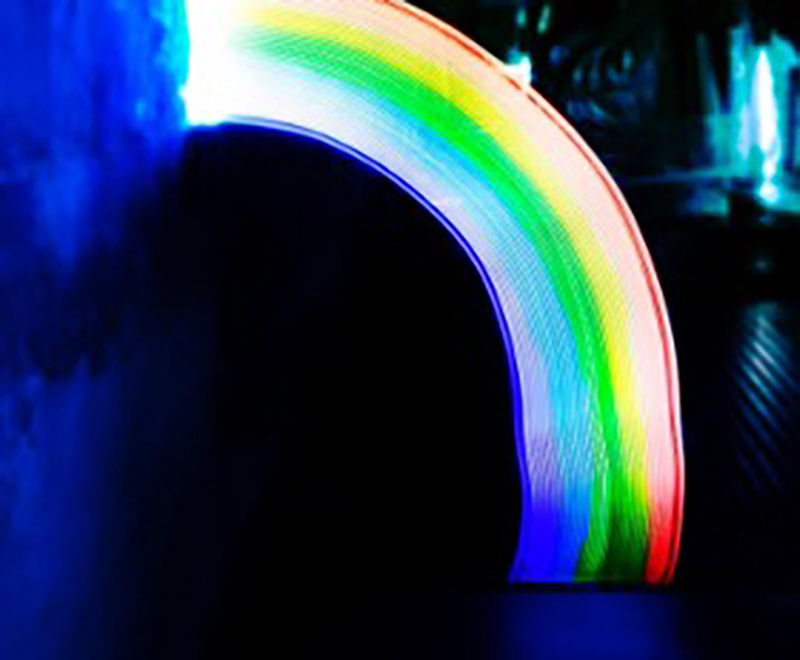By Judy Quinones, ABO-AC

In today's fast-paced, tech-driven world, blue light is everywhere – emanating from our screens, LED bulbs, and the sun. Blue light offers benefits as well as potential concerns for our eye health and overall well-being. Let's delve into the world of blue light to gain insight and discover how to maintain a healthy relationship with our ever-present companion.
Deciphering Blue Light: It’s All About the Spectrum
To understand blue light, we first need to take a peek at the electromagnetic spectrum. This fascinating spectrum encompasses all types of electromagnetic radiation, categorized by their wavelengths and frequencies. Among these, we find visible light, the portion perceptible to the human eye. Visible light can be broken down by color and wavelength, stretching from the shorter violet end at 380nm to the longer red end at 700nm (Science Mission Directorate. "Visible Light" NASA Science. 2010. National Aeronautics and Space Administration. 20 Sep. 2023 science.nasa.gov/ems/09_visiblelight.)
Now, let’s focus on blue light, which resides between 380nm and 500nm and is the most energetic part of the visible light spectrum.
Blue light itself can be further divided into two marked categories each with distinct properties and influences on both our visual and nonvisual functions:
- Violet-blue light (380nm - 450nm): The Trouble-Maker Also known as high-energy violet (HEV), this violet-blue range can wreak havoc on our eye tissues through photochemical reactions. Prolonged exposure to digital screens emitting violet-blue light has been associated with digital eye strain, but it's crucial to note that conclusive findings require further research (Zhao, Zhi-Chun et al. “Research progress about the effect and prevention of blue light on eyes.” International journal of ophthalmology vol. 11,12 1999-2003. 18 Dec. 2018, doi:10.18240/ijo.2018.12.20).
- Blue-turquoise light (450nm-500 nm): The Versatile Performer
This range is associated with several benefits:
- Circadian Rhythm Regulation: Blue-turquoise light during the day helps keep our internal body clock in check, ensuring wakefulness and alertness.
- Melatonin Suppression: By suppressing melatonin production during daylight hours, it helps us stay awake. However, encountering it in the evening can disrupt our sleep patterns.
- Mood and Alertness: Blue-turquoise light stimulates the release of neurotransmitters like dopamine and serotonin, influencing mood and alertness regulation.
Blue Light: Both Friend & Foe
The sun, our biggest natural source of blue light, scatters its shorter-wavelength, high-energy blue light across our atmosphere, giving us the blue skies we love. Yet, it's important to remember that sunlight along with the visible spectrum of colors, also contains UV and infrared rays, both of which can be harmful to our eyes and skin. (Alfredsson, Lars et al. “Insufficient Sun Exposure Has Become a Real Public Health Problem.” International Journal of Environmental Research and Public Health vol. 17,14 5014. 13 Jul. 2020, doi:10.3390/ijerph17145014).
Blue-turquoise light, while being our daytime ally, can turn into a sleep adversary when encountered at night. Exposure to this light before bedtime hampers melatonin production, making it harder to fall and stay asleep. Experts recommend limiting blue light exposure for 2-3 hours before bedtime to ensure a good night's sleep.
Excessive screen time dishing out violet-blue light (HEV) is thought to contribute to digital eye strain, causing eye fatigue, dryness, blurred vision, and headaches. Remember, when glued to screens, we blink less. To combat this, consider practicing the "20-20-20 Rule" – take a 20-second break to look at something 20 feet away every 20 minutes when using screens (“Should You Be Worried About Blue Light?” American Academy of Ophthalmology, 1 Sept. 2023, aao.org/eye-health/tips-prevention/should-you-be-worried-about-blue-light.).
In our modern lives filled with artificial lighting, our beloved gadgets emit blue light, and we often find ourselves staring directly at their screens. As our interaction with these digital marvels increases, it's essential to explore how the blue light they emit might affect our health. While low-intensity artificial blue light isn't an immediate threat to our eyes, comprehensive research on its long-term effects with specific light parameters and exposure conditions is still lacking. Studies on blue-light-filtering suggest that, for now, blue light doesn't significantly affect eye health regarding digital eye strain or age-related macular degeneration, but more research is needed. Understanding how artificial blue light influences human health is crucial as we continue to embrace technological advances.
Striking a Balance & Embracing the Spectrum:
As our reliance on digital devices grows, comprehending the effects of blue light is vital. Blue light can be a friend, boosting our mood, enhancing productivity, and regulating our circadian rhythm. However, overexposure to natural and artificial blue light sources, at the wrong times and in the wrong amounts, can contribute to eye health problems, sleep disruptions, and visual discomfort among others (Alfredsson, Lars et al. “Insufficient Sun Exposure Has Become a Real Public Health Problem.” International journal of environmental research and public health vol. 17,14 5014. 13 Jul. 2020, doi:10.3390/ijerph17145014).
Like many things in life, moderation is the key to achieving harmony with blue light. Fortunately, there are numerous resources to help shield us from excessive blue light, whether it's natural or artificial. From an optical perspective, when dealing with natural blue light, it's crucial to remember to wear sunglasses that effectively filter out UVR. For artificial blue light, consider using blue light filters on our devices and limiting screen time before bedtime. Additionally, eyeglasses equipped with anti-reflective coatings can reduce glare and ease eye strain caused by prolonged screen usage.
When it comes to lighting choices, opt for lower-intensity bulbs like incandescent or warm LEDs, to promote better sleep. LED bulbs come in different color temperatures, with warm white emitting a cozy, yellowish light, and cool white LEDs emitting blue light, which may interfere with sleep (Cougnard-Gregoire, Audrey et al. “Blue Light Exposure: Ocular Hazards and Prevention-A Narrative Review.” Ophthalmology and therapy vol. 12,2 (2023): 755-788. doi:10.1007/s40123-023-00675-3).
While ongoing research continues to unveil the impacts of blue light, our awareness is the key to keeping the “blue light blues” at bay and ensuring that blue light remains a source of positivity in our lives. Stay informed, stay balanced, and keep those blues in check.












